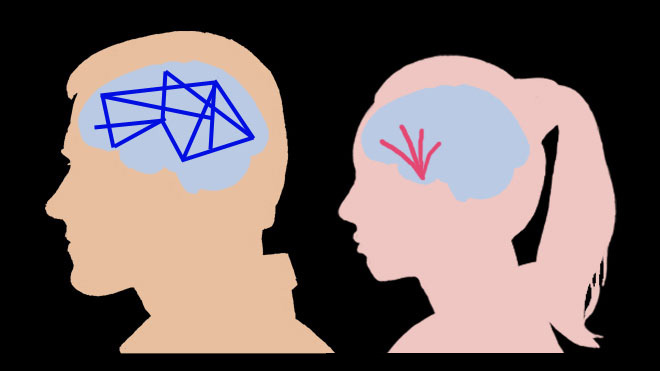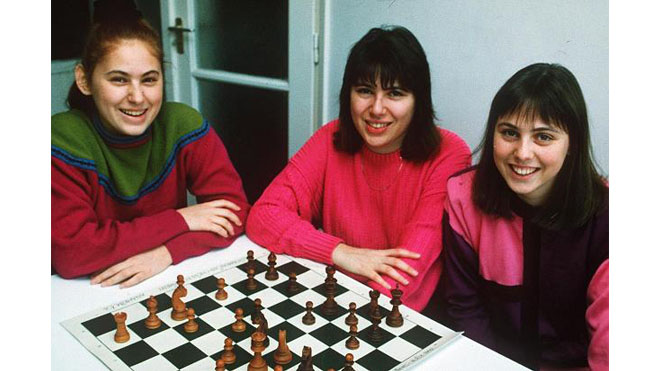Monday, December 22, 2025
Why do Girls throughout the World outperform Boys in School?

The short answer is: girls follow social trends, while boys judge the value of reasons.
To better understand a social phenomenon, it helps to think in terms of a bell curve of general tendencies. Of course, there are some very reasonable girls and some highly social boys. What I describe below is the main difference between the sexes from kindergarten through a master's degree that affects school grades the most.
Evolution never intended for boys and girls to be compared as equals. It's a little absurd when you think about it. Evolution wired boys and girls brains to serve different purposes in society. The purpose of boys is to make reasoned decisions about how the family or group should be. That is, to think outside the social circle and lead (external leadership). The purpose of girls is to influence the family or group to follow or mimic popular social trends and rules (internal leadership). That is, to teach children culture. [Women create and maintain this kind of relationship].
Note: There is much more to internal leadership that I will not discuss in this essay.
This does not mean girls can't make reasoned decisions or boys can't remember to follow directions; it just means evolution wired our brains for this arrangement. Boys are more externally oriented, and girls are more internally oriented. Together, they make a good team.
Note: I am not a brain scientist. What follows is my theory. Theorizing is what I do.
A social brain is an emotional brain. The emotional brain is better at encoding memories more strongly. Most activity in a girl's brain is tied to two areas: the center of the brain, where emotion is generated, and the front of the brain, where memories are stored. Brains are made up of both gray matter and white matter. White matter is the internal highway system that connects the different parts of the brain, like the twigs, branches, and trunk of the inside of a tree. Because girls have more white matter than boys, girls can multitask. The ratio between white and gray matter may also help to account for the emotional differences between the sexes. The gray matter provides the ability to understand. This stabilizes the emotions generated by the center of the brain. If this is true, it may help explain where boys get their confidence and why girls worry more.
Girls identify and memorize social rules. On a multiple-choice test, girls can more naturally recognize the thought trend of the question being asked and spot the socially expected answer. This might also apply somewhat to IQ tests.
Boys are more likely to think independently (aloof) and consequently misunderstand the question, resulting in choosing the wrong answer. I know this because this was me throughout my school life. Boys are more likely to observe and analyze to derive an answer. The neurocircuitry that makes this possible may reside in gray matter. Gray matter is like the leaves that cover the outer layers of a tree.
Girls are more likely to follow rules or instructions without questioning authority. Whether it's true or false, right or wrong, is of secondary importance. Girls follow rules to stay connected to the social track. They don't venture alone into free thinking and sometimes socially incorrect intellectual territory. Evolution gave girls the purpose of breeding the human species into social groups like a school of fish or a pack of dogs, as opposed to solitary animals like the octopus and cats. Those students who memorize information and follow rules do well in school.
Girls are Cars and Boys are Jeeps
Girls are more like cars; they stay on the social highway. Boys are more like Jeeps—they go anywhere they want.
Here are two examples of social rules and memory:
1. Many years ago, when I was in college, I noticed a young, attractive, intelligent, and athletic German woman seemingly dominate the class with the speed with which she was finishing projects. It was a mechanical drafting class (technical drawings). She told me in a conversation she could memorize a phone book, and I believe her.
A few weeks later, the teacher assigned the whole class a unique project to do over the weekend with no instructions on how to complete it. We had to figure out or invent a solution. The vast majority of the students, including the German woman, failed to do the project at all because it was too difficult. I was the only one to figure out a solution that worked, and the teacher held it up in front of the class as a perfect example of what he was trying to teach us.
This does not mean I am a good student. In fact, I struggled throughout my school history just to achieve C’s and D's, partly because I'm not good at following social trends; I don't just accept at face value what the teacher wants us to believe. I think and make my own judgments. If I had just followed social trends, I would have been in the vast majority and breezed through school easier.
2. In the early 2000's, I watched a PBS NOVA documentary about a father in the eastern European country of Hungary who trained his three daughters to become the best women chess players in world history. They were beyond extraordinary. 10–14-year-old girls were easily beating experienced older men.
Years later, when the girls were adult women at the end of their chess playing careers, they helped science learn how they were so good. It turns out, their father had them memorize every play strategy and tactic from every chess book he could find until they were etched into the part of the brain normally used for facial recognition.
Girls are innately better at recognizing faces than boys. Faces make them emotional, and emotion encodes memories more deeply.
The eldest sister, Susan Polgar, participated in an experiment by playing a computer. The computer was instructed to play normally at first. Susan won every game. Then the computer was instructed to introduce a completely new tactic that is nonexistent in the chess world. When Susan didn’t recognize the tactic, she didn’t know what to do and could not proceed.
I think these two examples reveal a boundary between white and gray matter thinking. Between social following and independent thinking.
The origin of external leadership
Highly social people in general, both boys and girls, have difficulty understanding the difference between socially correct and truly correct. 200 years ago, it was socially correct to own a slave. Some slave owners even pointed to the Bible as proof that they were only following the will of God. The social climate has changed, but the human instinct to follow the current trend has not. Because people in general follow more than they reason, society is somewhat disconnected from reality.
A reasoned brain is a brain that understands. A boy who understands the world can see the big picture and is thus better able to provide direction (external leadership). A boy's brain activity is more evenly distributed throughout his brain. The gray matter of the brain (the outer layer) might be where reasons are realized. Boys have more gray matter than girls. Boys are more able to judge the difference between what is important and what is superficial, therefore boys are more likely to challenge authority and remember only what they reason is important. Reason helps boys theorize, develop strategies, and think without social support, which are important leadership traits and important fatherly traits.
School is boring
The problem for boys in school is that they're directed to memorize and follow too many subjects or subject details that lead nowhere. Boys are thirsty (like Evel Knievel) to make their own judgment about the necessity of what they're told they must learn.

For example, when boys judge subjects such as drama, speech, foreign languages, PE, or algebra as superficial or pointless, they lose interest in these subjects. Also, this distracts boys from the most important subjects, some of which are not even taught in school, like logic and critical thinking, the assertive process, the use of the subconscious, how to develop grit, and, of course, evolution. Every generation evolution sculpts human behavior, making it a must-understand educational topic.
There is a difference between socially correct and truly correct. And there is a difference between memorization and true learning. If a student is not interested in what he or she is learning, then the student will only memorize the information long enough to pass a test. That is not true education, and yet it is what most students do.
Some time ago, I watched a documentary that showed scientists interviewing Master of Science graduates on graduation day. The interviewers asked the graduates basic science questions that were covered in the previous years they were in school to test their understanding of the world they live in. None of the graduates could answer the questions correctly, demonstrating that school is largely a social memorization game.
END
To better understand a social phenomenon, it helps to think in terms of a bell curve of general tendencies. Of course, there are some very reasonable girls and some highly social boys. What I describe below is the main difference between the sexes from kindergarten through a master's degree that affects school grades the most.
Evolution never intended for boys and girls to be compared as equals. It's a little absurd when you think about it. Evolution wired boys and girls brains to serve different purposes in society. The purpose of boys is to make reasoned decisions about how the family or group should be. That is, to think outside the social circle and lead (external leadership). The purpose of girls is to influence the family or group to follow or mimic popular social trends and rules (internal leadership). That is, to teach children culture. [Women create and maintain this kind of relationship].
Note: There is much more to internal leadership that I will not discuss in this essay.
This does not mean girls can't make reasoned decisions or boys can't remember to follow directions; it just means evolution wired our brains for this arrangement. Boys are more externally oriented, and girls are more internally oriented. Together, they make a good team.
Note: I am not a brain scientist. What follows is my theory. Theorizing is what I do.
A social brain is an emotional brain. The emotional brain is better at encoding memories more strongly. Most activity in a girl's brain is tied to two areas: the center of the brain, where emotion is generated, and the front of the brain, where memories are stored. Brains are made up of both gray matter and white matter. White matter is the internal highway system that connects the different parts of the brain, like the twigs, branches, and trunk of the inside of a tree. Because girls have more white matter than boys, girls can multitask. The ratio between white and gray matter may also help to account for the emotional differences between the sexes. The gray matter provides the ability to understand. This stabilizes the emotions generated by the center of the brain. If this is true, it may help explain where boys get their confidence and why girls worry more.
Girls identify and memorize social rules. On a multiple-choice test, girls can more naturally recognize the thought trend of the question being asked and spot the socially expected answer. This might also apply somewhat to IQ tests.
Boys are more likely to think independently (aloof) and consequently misunderstand the question, resulting in choosing the wrong answer. I know this because this was me throughout my school life. Boys are more likely to observe and analyze to derive an answer. The neurocircuitry that makes this possible may reside in gray matter. Gray matter is like the leaves that cover the outer layers of a tree.
Girls are more likely to follow rules or instructions without questioning authority. Whether it's true or false, right or wrong, is of secondary importance. Girls follow rules to stay connected to the social track. They don't venture alone into free thinking and sometimes socially incorrect intellectual territory. Evolution gave girls the purpose of breeding the human species into social groups like a school of fish or a pack of dogs, as opposed to solitary animals like the octopus and cats. Those students who memorize information and follow rules do well in school.
Girls are Cars and Boys are Jeeps
Girls are more like cars; they stay on the social highway. Boys are more like Jeeps—they go anywhere they want.
Here are two examples of social rules and memory:
1. Many years ago, when I was in college, I noticed a young, attractive, intelligent, and athletic German woman seemingly dominate the class with the speed with which she was finishing projects. It was a mechanical drafting class (technical drawings). She told me in a conversation she could memorize a phone book, and I believe her.
A few weeks later, the teacher assigned the whole class a unique project to do over the weekend with no instructions on how to complete it. We had to figure out or invent a solution. The vast majority of the students, including the German woman, failed to do the project at all because it was too difficult. I was the only one to figure out a solution that worked, and the teacher held it up in front of the class as a perfect example of what he was trying to teach us.
This does not mean I am a good student. In fact, I struggled throughout my school history just to achieve C’s and D's, partly because I'm not good at following social trends; I don't just accept at face value what the teacher wants us to believe. I think and make my own judgments. If I had just followed social trends, I would have been in the vast majority and breezed through school easier.
2. In the early 2000's, I watched a PBS NOVA documentary about a father in the eastern European country of Hungary who trained his three daughters to become the best women chess players in world history. They were beyond extraordinary. 10–14-year-old girls were easily beating experienced older men.
Years later, when the girls were adult women at the end of their chess playing careers, they helped science learn how they were so good. It turns out, their father had them memorize every play strategy and tactic from every chess book he could find until they were etched into the part of the brain normally used for facial recognition.
Girls are innately better at recognizing faces than boys. Faces make them emotional, and emotion encodes memories more deeply.
The eldest sister, Susan Polgar, participated in an experiment by playing a computer. The computer was instructed to play normally at first. Susan won every game. Then the computer was instructed to introduce a completely new tactic that is nonexistent in the chess world. When Susan didn’t recognize the tactic, she didn’t know what to do and could not proceed.
I think these two examples reveal a boundary between white and gray matter thinking. Between social following and independent thinking.
The origin of external leadership
Highly social people in general, both boys and girls, have difficulty understanding the difference between socially correct and truly correct. 200 years ago, it was socially correct to own a slave. Some slave owners even pointed to the Bible as proof that they were only following the will of God. The social climate has changed, but the human instinct to follow the current trend has not. Because people in general follow more than they reason, society is somewhat disconnected from reality.
A reasoned brain is a brain that understands. A boy who understands the world can see the big picture and is thus better able to provide direction (external leadership). A boy's brain activity is more evenly distributed throughout his brain. The gray matter of the brain (the outer layer) might be where reasons are realized. Boys have more gray matter than girls. Boys are more able to judge the difference between what is important and what is superficial, therefore boys are more likely to challenge authority and remember only what they reason is important. Reason helps boys theorize, develop strategies, and think without social support, which are important leadership traits and important fatherly traits.
School is boring
The problem for boys in school is that they're directed to memorize and follow too many subjects or subject details that lead nowhere. Boys are thirsty (like Evel Knievel) to make their own judgment about the necessity of what they're told they must learn.

Evel Knievel was an American stunt performer. He was a pioneer in ramp-to-ramp motorcycle jumps and was popular with young boys during the mid-1970s.
For example, when boys judge subjects such as drama, speech, foreign languages, PE, or algebra as superficial or pointless, they lose interest in these subjects. Also, this distracts boys from the most important subjects, some of which are not even taught in school, like logic and critical thinking, the assertive process, the use of the subconscious, how to develop grit, and, of course, evolution. Every generation evolution sculpts human behavior, making it a must-understand educational topic.
There is a difference between socially correct and truly correct. And there is a difference between memorization and true learning. If a student is not interested in what he or she is learning, then the student will only memorize the information long enough to pass a test. That is not true education, and yet it is what most students do.
Some time ago, I watched a documentary that showed scientists interviewing Master of Science graduates on graduation day. The interviewers asked the graduates basic science questions that were covered in the previous years they were in school to test their understanding of the world they live in. None of the graduates could answer the questions correctly, demonstrating that school is largely a social memorization game.
END


